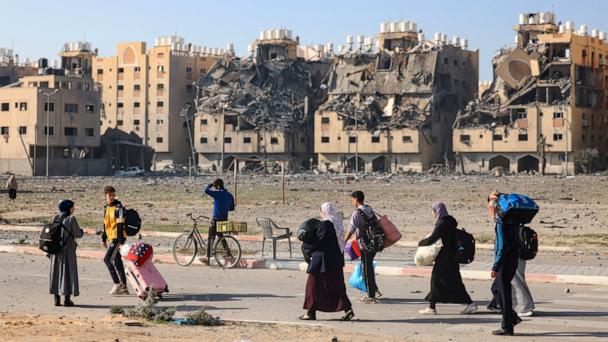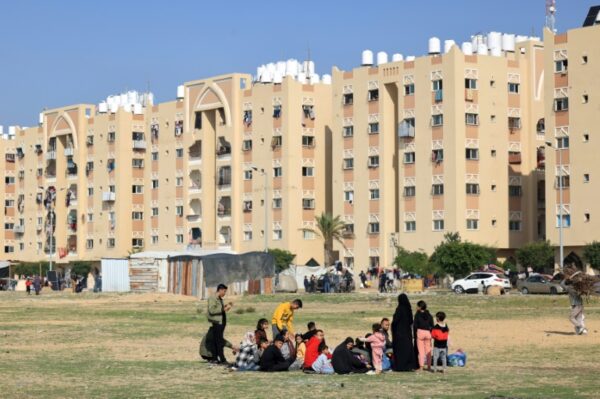Khan Yunis – At almost exactly the same time Israeli negotiators pulled out of deadlocked truce talks in Qatar on Saturday, Israeli jets sent a prestige Doha-funded housing development in the Gaza Strip up in smoke.

Residents of the Qatari-funded Hamad City residential complex in the Gaza Strip sit outside after Israeli air strikes hit the development
MAHMUD HAMS
Hamad City is named for the former emir of the Gulf state, Sheikh Hamad bin Khalifa Al-Thani, who laid the foundation stone on a visit 11 years ago.
Inaugurated in 2016, it was still among the newest projects in the Gaza Strip, the housing complex in the city of Khan Yunis boasting an impressive mosque, shops, and gardens.
The first flats — more than 1,000 of them — were provided to Palestinians whose homes were destroyed in the war between Israel and Hamas two years earlier.
On Saturday it happened again, a day after a Qatar-brokered pause in the current war between Israel and Hamas expired.
First, their phones pinged around noon with an “immediate” evacuation order SMS sent by the Israeli army, which says the system is aimed at minimizing civilian casualties.
Around an hour later, five Israeli air strikes rained down on the neighborhood in the space of just two minutes.
Bombs slammed into the pale apartment blocks one by one, reducing them largely to rubble and sending a huge pall of black smoke into the sky, as people fled and cries of ‘help!’ and ‘ambulance!’ rang out.
“At least we got through it,” 26-year-old Nader Abu Warda told AFP, amazed he was still alive.
No phones
The Israeli military has divided the Gaza Strip into 2,300 “blocs” and is now sending SMS messages to residents telling them to leave before they launch the strikes which they say will “eliminate Hamas”.
Around 1,200 people, mostly civilians, died in the Islamist movement’s October 7 assault on southern Israel and some 240 were taken hostage, according to Israeli authorities.
The Hamas-led Gaza Strip government says Israel’s campaign has killed more than 15,000 people, mostly civilians since it was launched eight weeks ago.
The United Nations humanitarian agency, OCHA, has highlighted that the warning messages do not indicate where the recipients should go.
Ibrahim al-Jamal, a civil servant in his 40s, said he does not have any “internet, any electricity or even a radio to receive information” and that he has “never seen this map” setting out the different blocs.
“Many people in Gaza have never heard of it and it wouldn’t matter anyway as the bombings are taking place everywhere,” he said.
Humanitarian bodies say the most vulnerable in Gaza are the estimated 1.7 million displaced people.
Many of them do not have access to phones and have to rely on warning leaflets dropped by planes, not visible from inside an apartment.
‘Go where?’
According to the Gaza Strip’s Civil Defence emergency and rescue organization, in recent weeks “hundreds of displaced families” had been taking refuge in 3,000 apartments at Hamad City.
Mohammed Foura, 21, already displaced once from Gaza City, told AFP that half an hour before the strike he had been warned by other residents to flee.
They shouted: “Get out, get out”, he said, as families piled their belongings into cars or carried them away in enormous bundles.
Nader Abu Warda fled Jabalia, near Gaza City, at the start of the war and no longer knows which way to go or what to do.
He, his wife, and three children had been staying in a friend’s apartment in the complex.
“They told us ‘Gaza City is a war zone’, now it’s Khan Yunis,” he said. “Yesterday, they were saying ‘evacuate the east of Khan Yunis’. Today, they say ‘evacuate the west’,” he added, visibly exasperated.
“Where are we going now, into the sea? Where are we going to put our children to bed?”
AFP/FRANCE24

Leave a Reply
You must be logged in to post a comment.